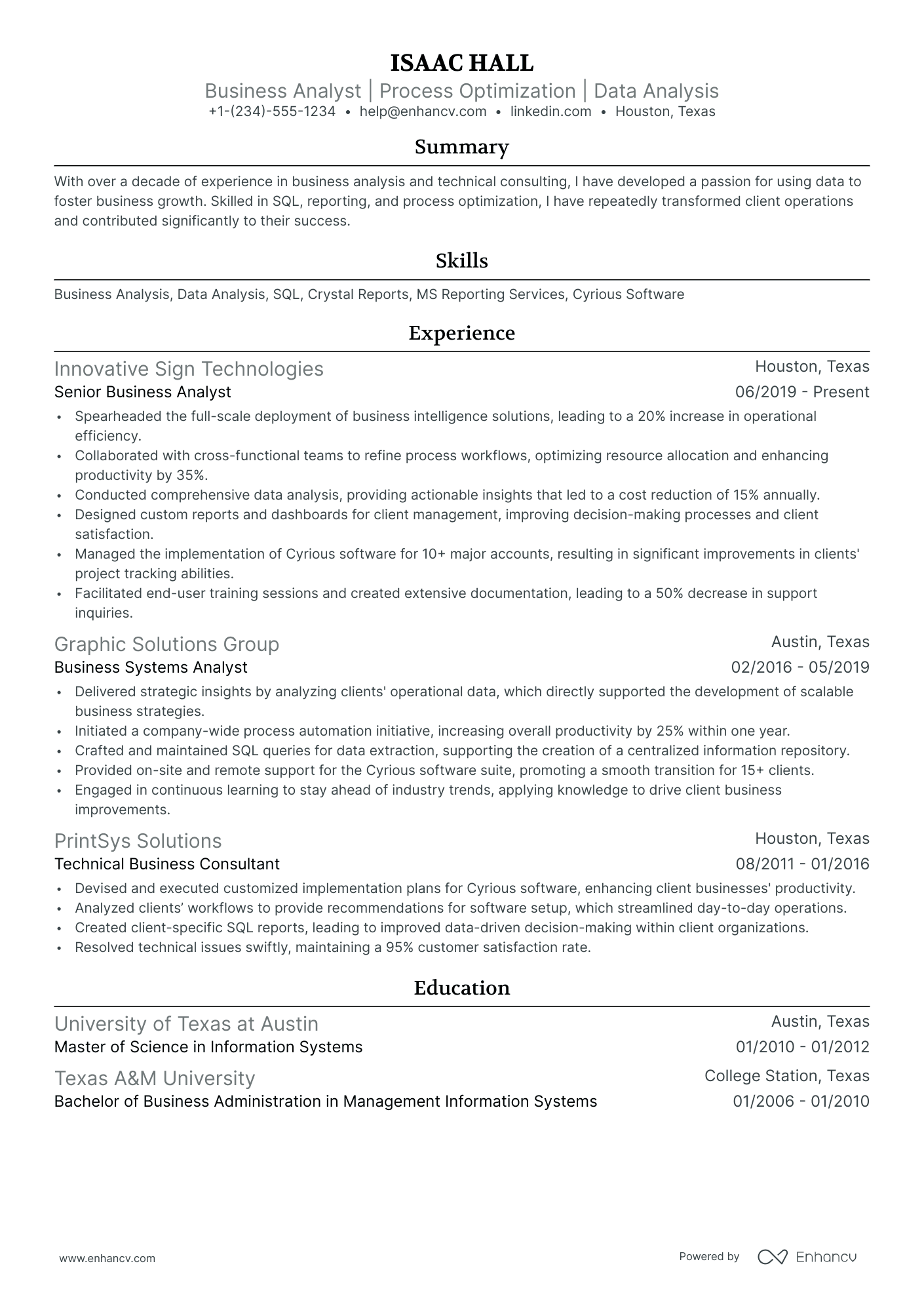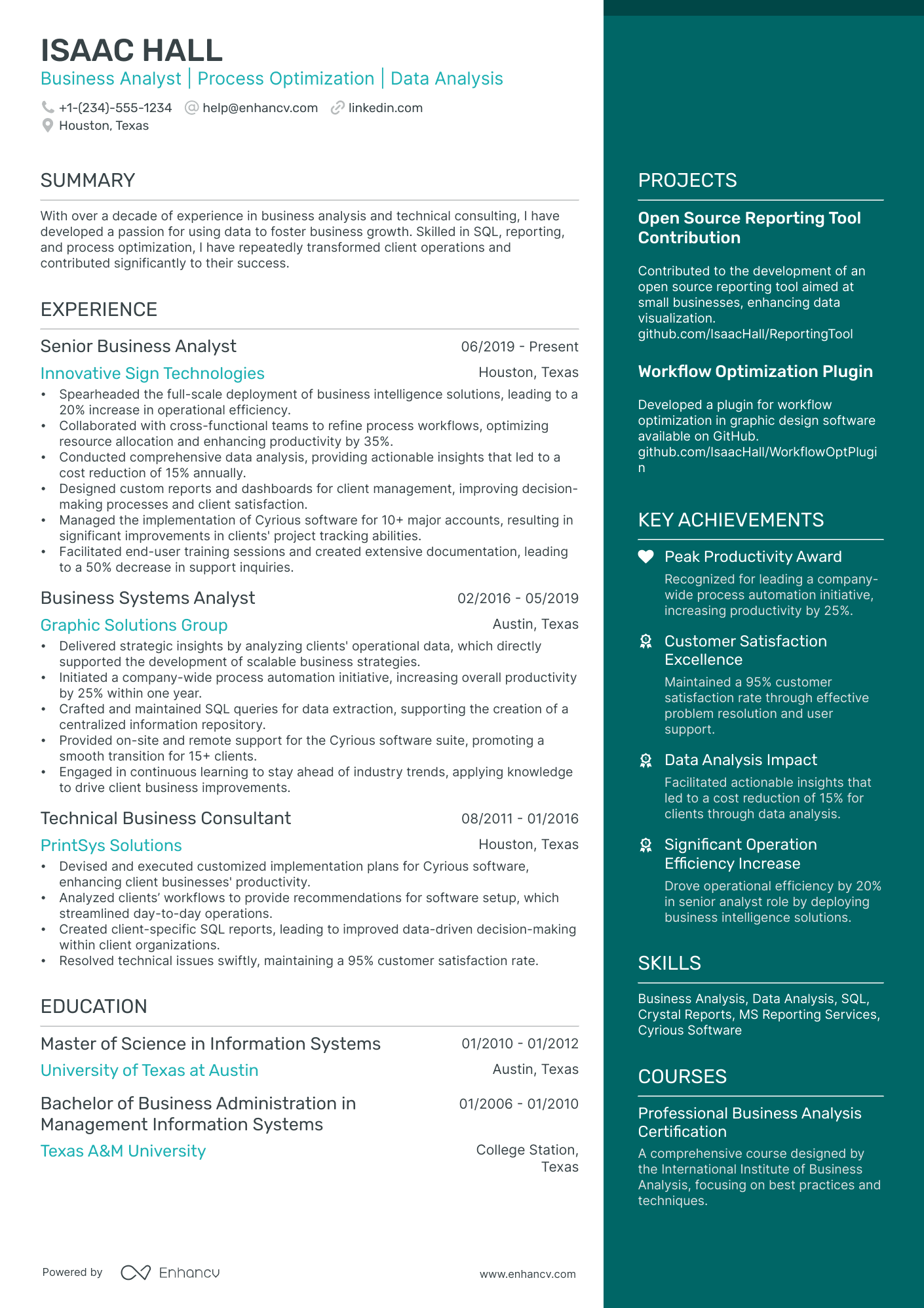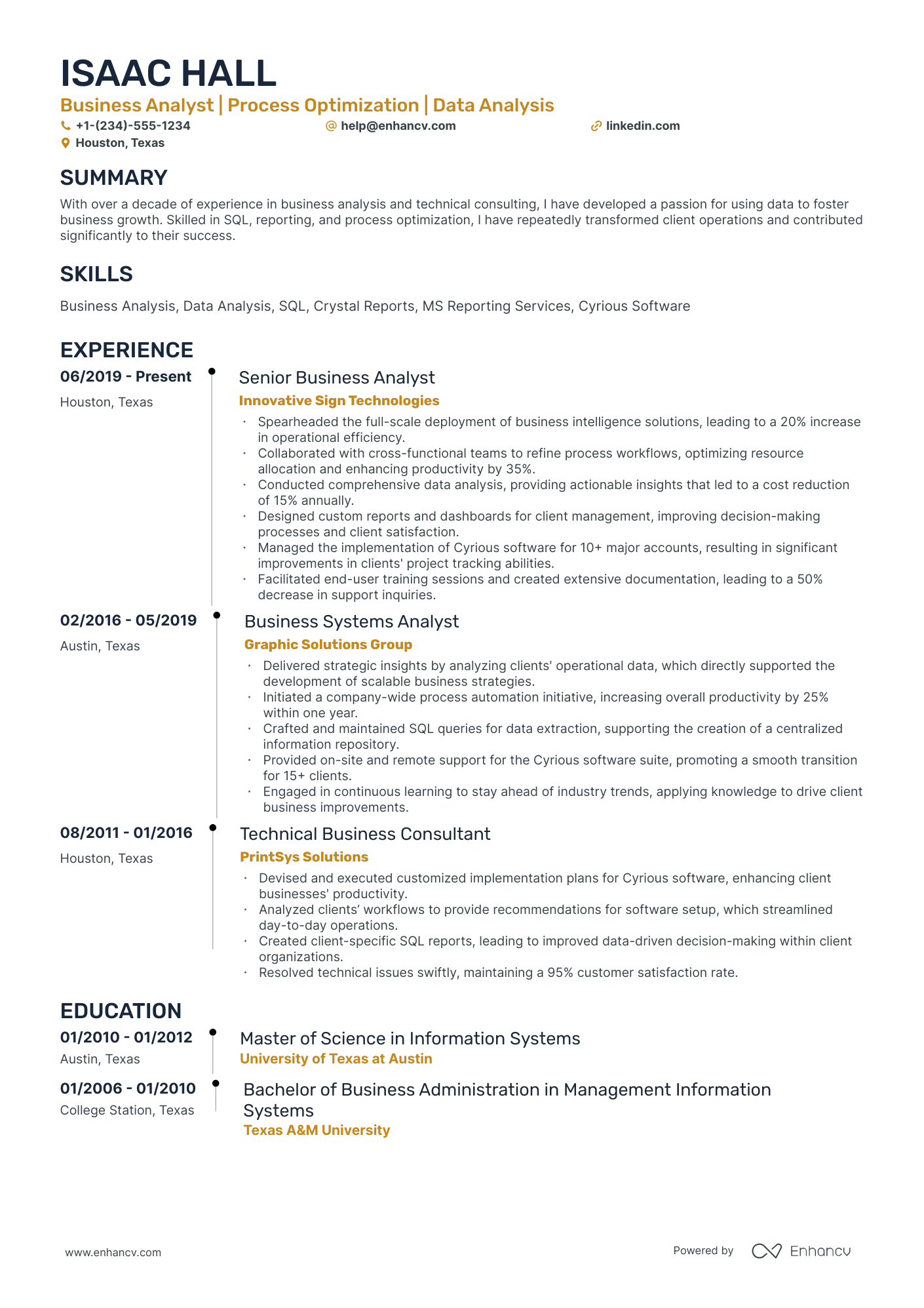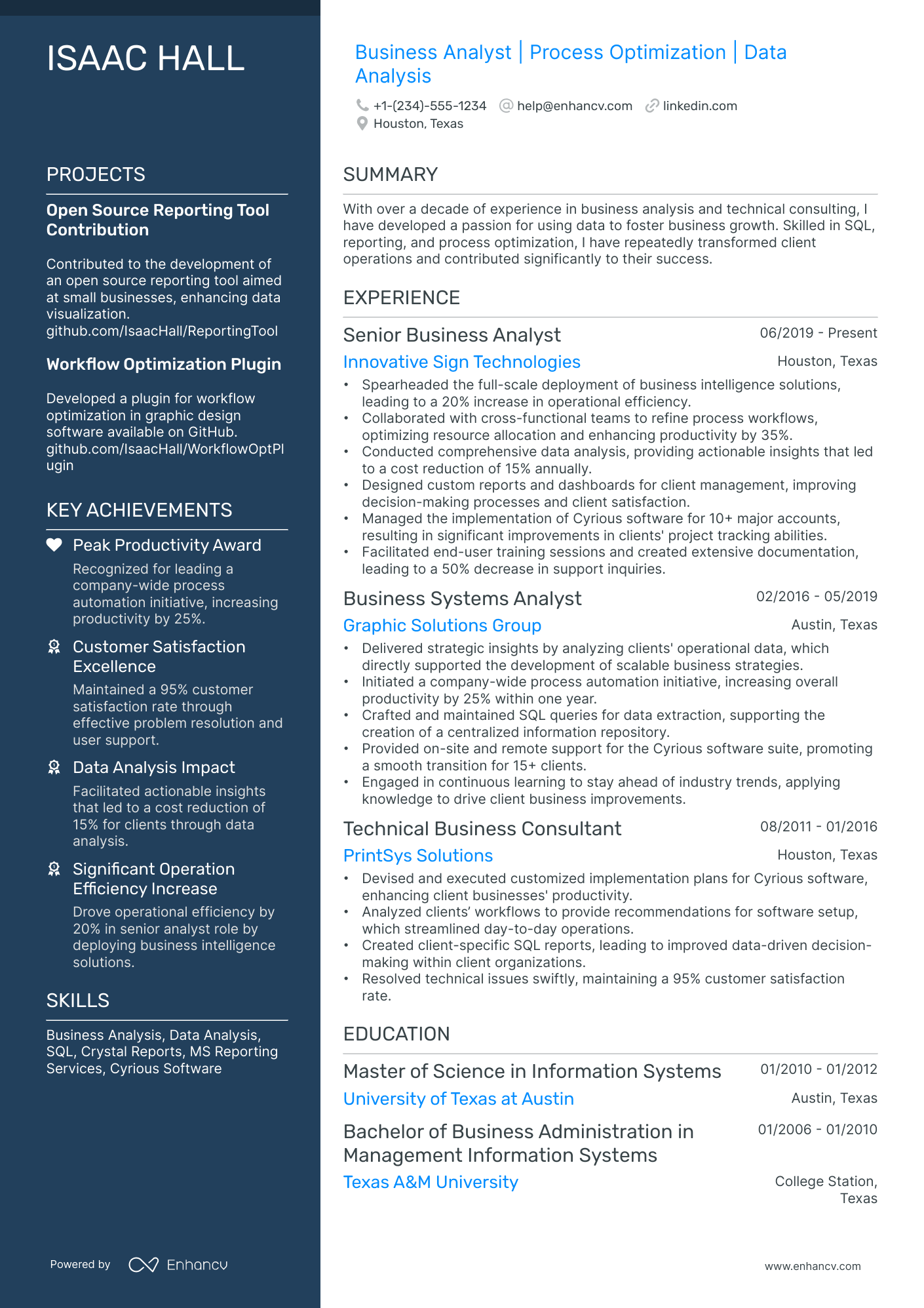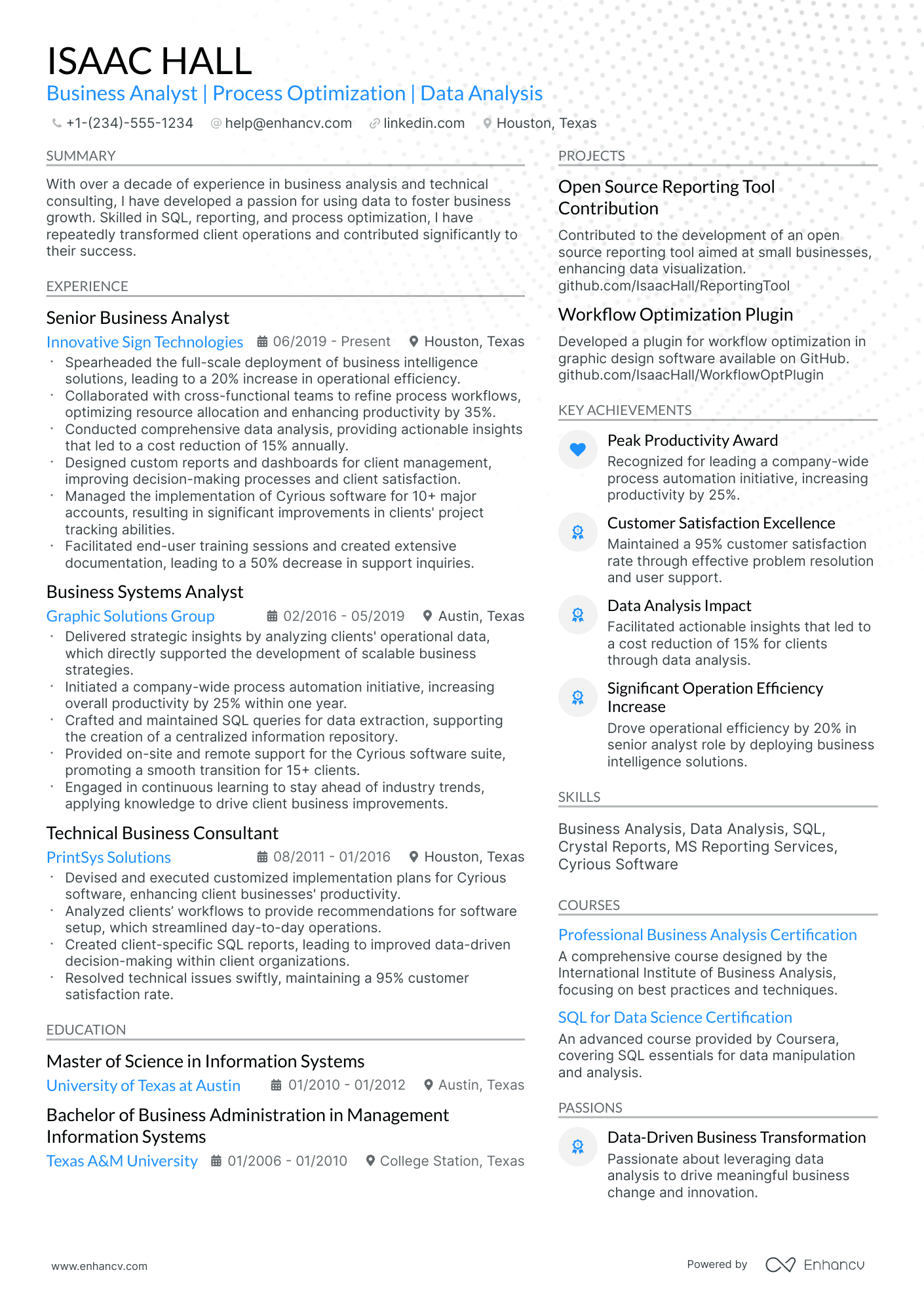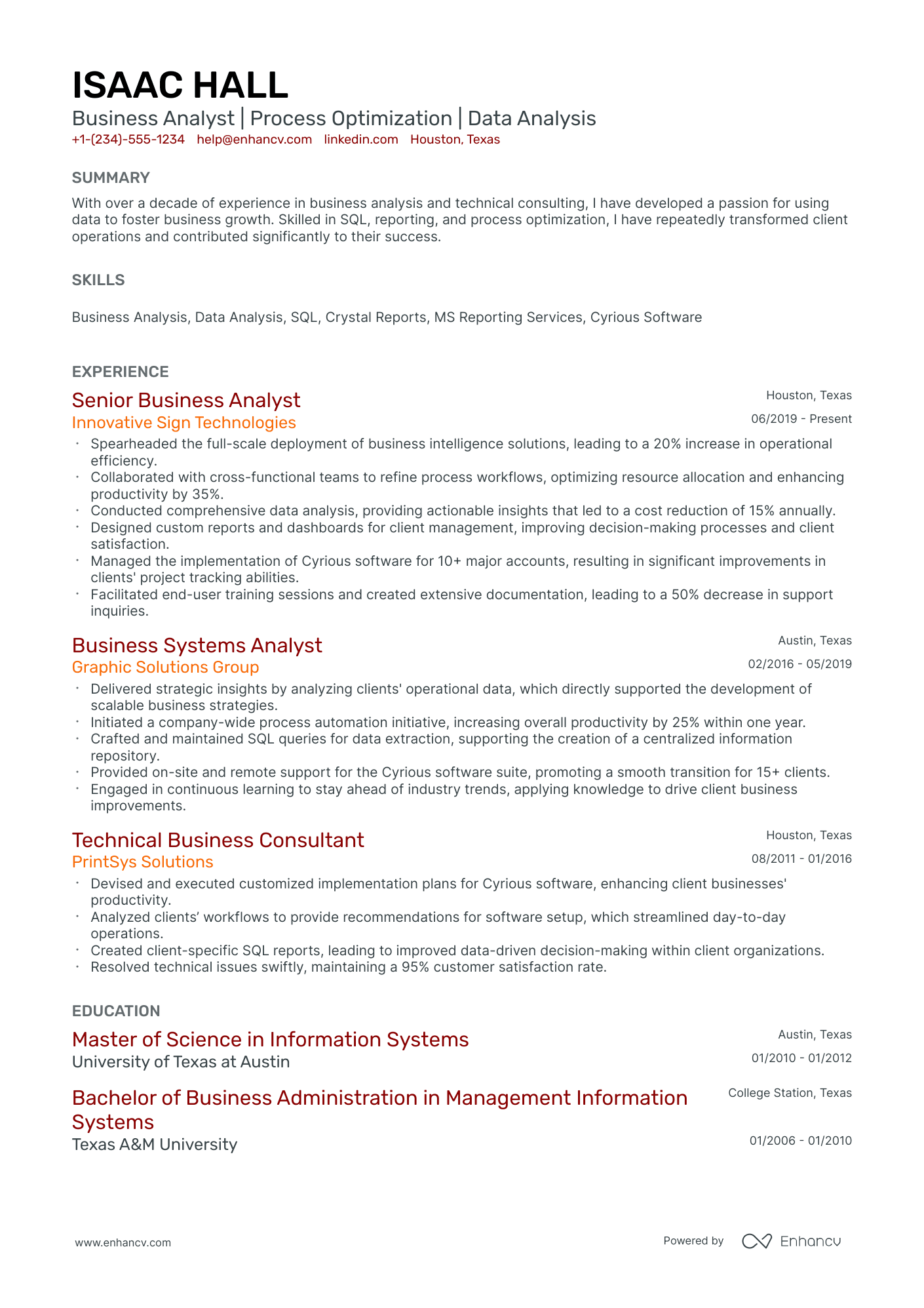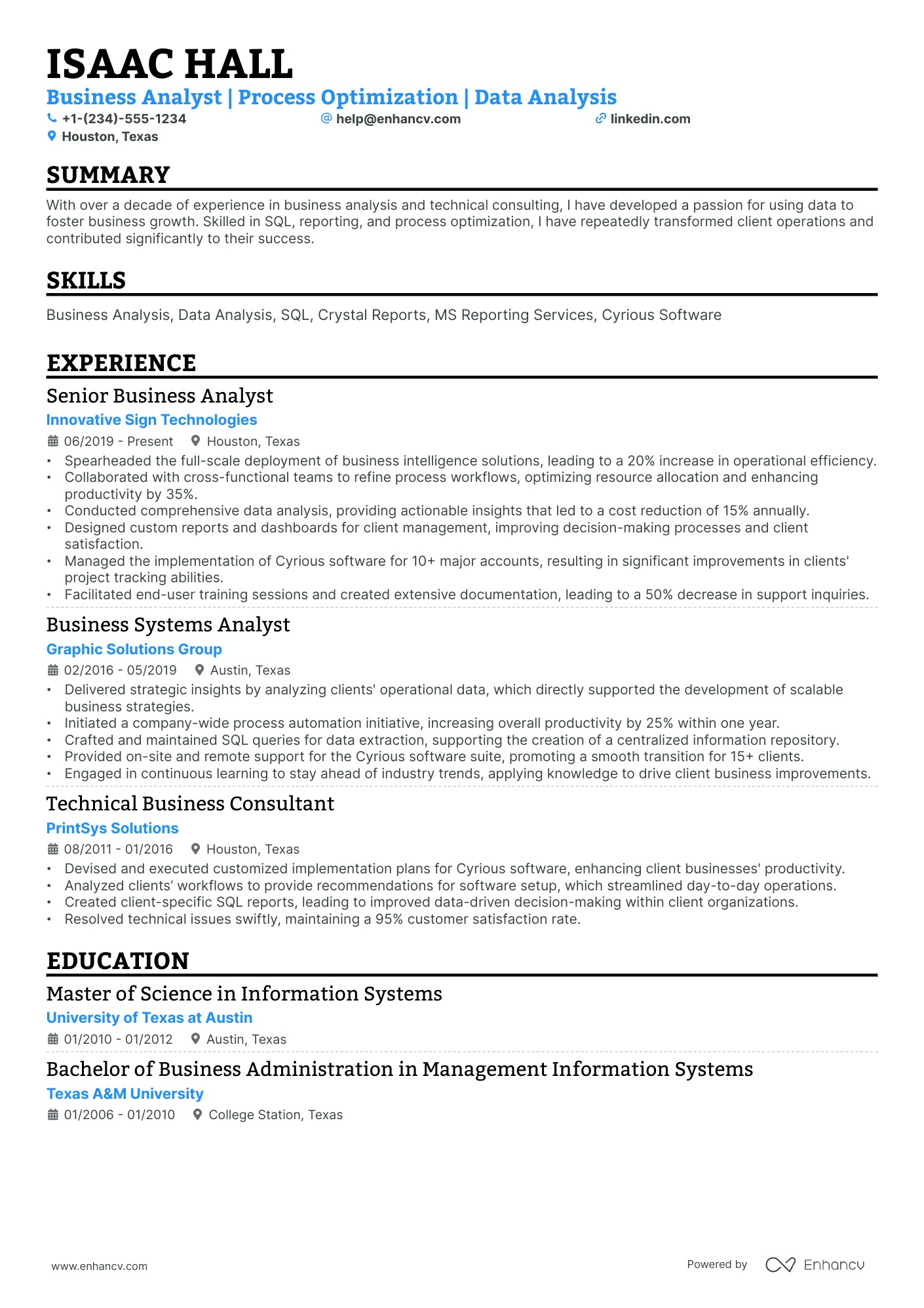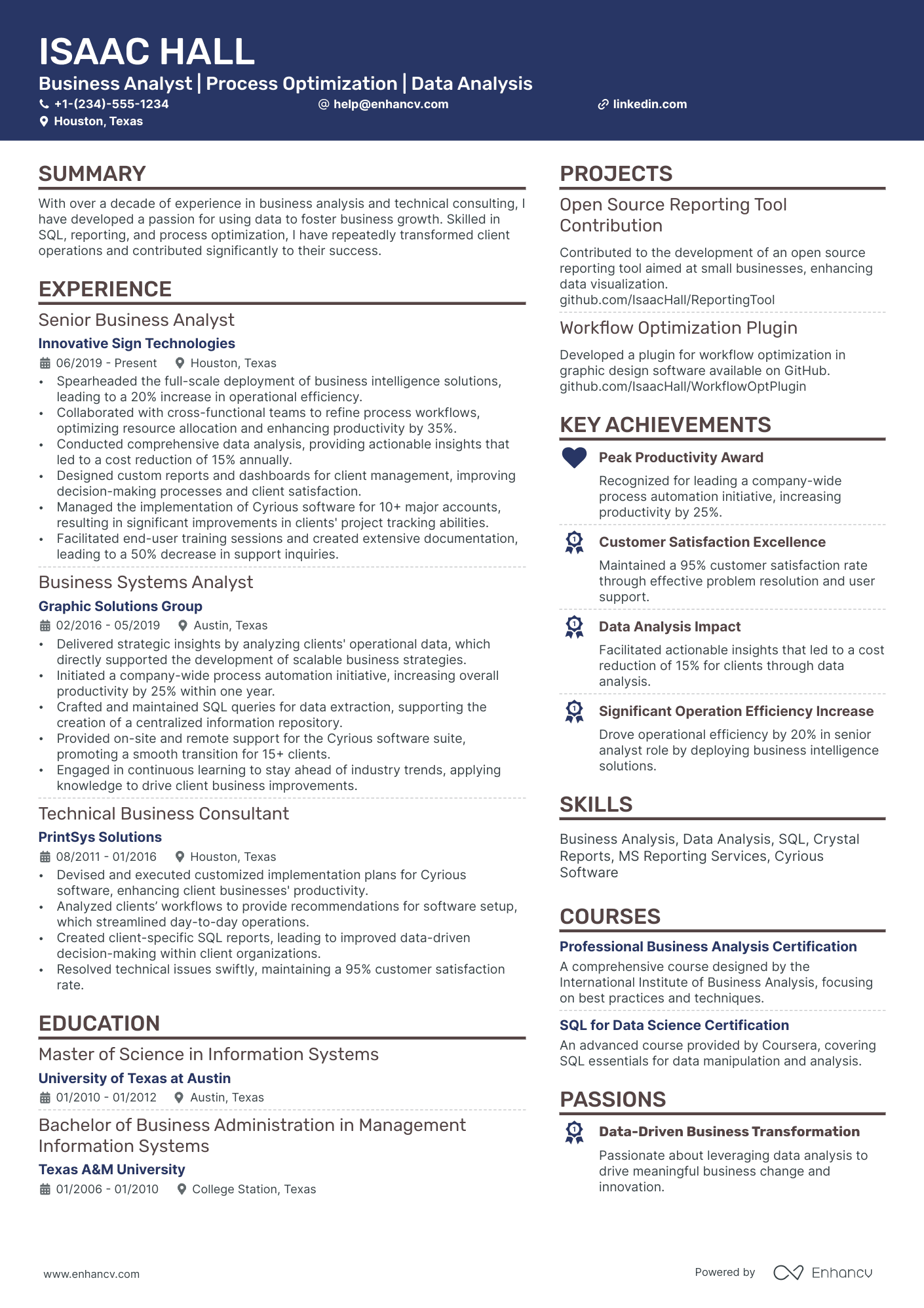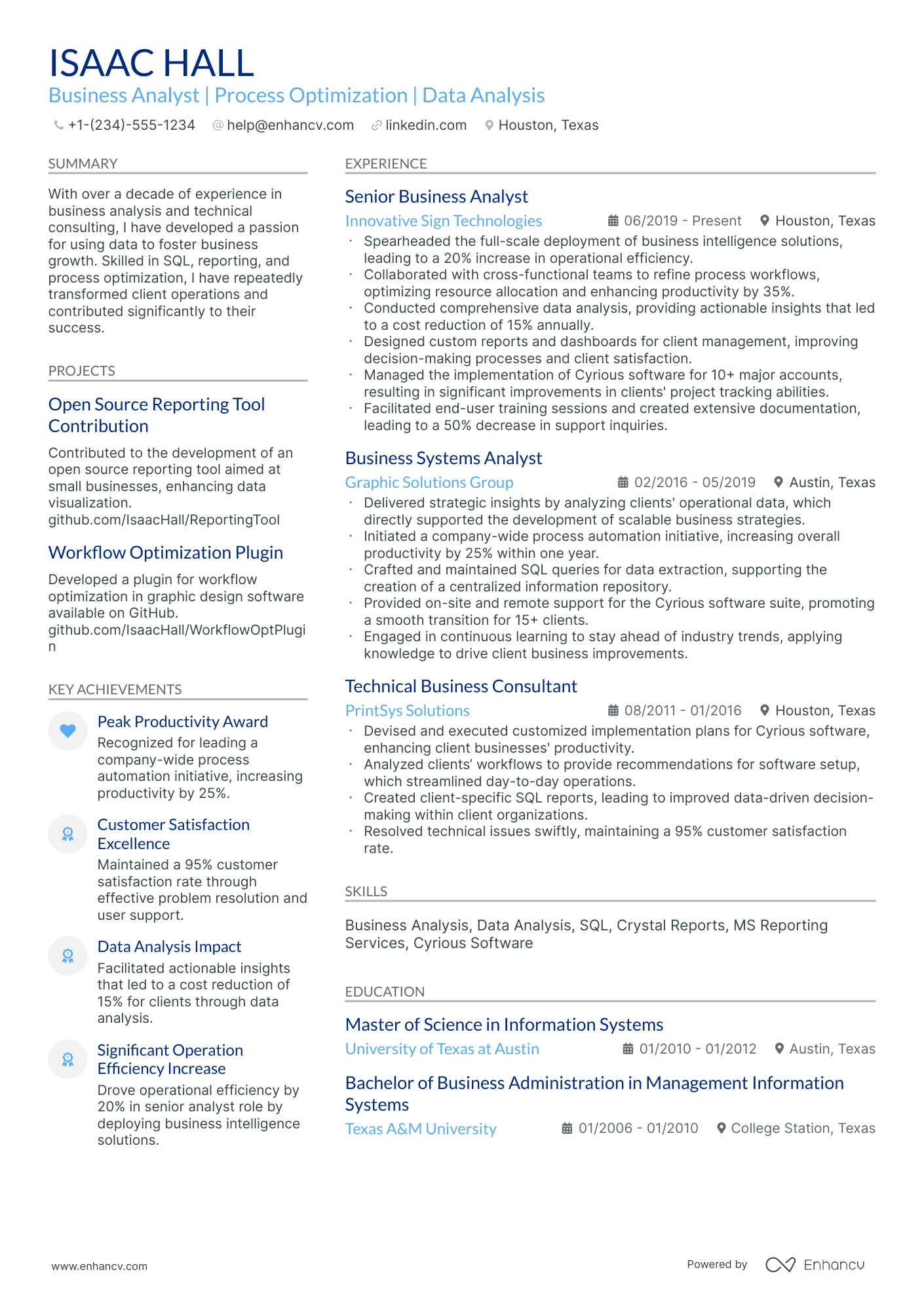As a software business analyst, you might struggle with effectively showcasing your diverse project management skills and technical proficiencies on your resume. Our guide provides targeted advice to help you concisely articulate your achievements and tailor your experience to stand out to potential employers.
- Utilize real-life examples to refine your software business analyst resume;
- Effectively write the experience section of your software business analyst resume, even if you have minimal or no professional experience;
- Incorporate the industry's top 10 essential skills throughout your resume;
- Include your education and certifications to highlight your specific expertise.
If the software business analyst resume isn't the right one for you, take a look at other related guides we have:
- Senior Developer Resume Example
- Embedded Software Engineer Resume Example
- Principal Software Engineer Resume Example
- Software Specialist Resume Example
- Sharepoint Developer Resume Example
- Java Web Developer Resume Example
- Senior Web Developer Resume Example
- Drupal Developer Resume Example
- J2EE Developer Resume Example
- Freelance Developer Resume Example
The importance of format and layout in your software business analyst resume
Consider you're an HR professional at company X, evaluating two software business analyst candidate resumes. John Smith presents a simple, traditional, and easy-to-read resume. Edward Price, however, uses a non-conventional, often illegible format. Whose resume would you spend more time on to understand their experience? This scenario underscores the importance of your software business analyst resume’s design. It should be simply formatted and clearly communicate why you are the ideal candidate for the role.
Achieve this balance by:
- Listing your experience, beginning with the most recent and relevant, in reverse chronological order;
- Ensuring your header contains essential information, such as contact details, a headline, and a portfolio link. Include a professional photo in the software business analyst resume header if you have one;
- Including only the most important and relevant resume sections to showcase your expertise and stand out from other candidates;
- Editing your software business analyst resume to be no longer than two pages if you have extensive relevant experience. Use your limited resume space judiciously.
Also, remember that your software business analyst resume might initially be scanned by an Applicant Tracker System (ATS).
When it comes to ATS:
- Opt for simple and legible fonts like Raleway, Rubik, Lato, etc., making your experience easy for the ATS to scan;
- Use serif and sans-serif fonts, both of which are ATS-friendly;
- Avoid overused options like Arial and Times New Roman, which, while suitable, may lack personality.
Contrary to a common myth, our recent study shows that the ATS can effectively process both one-column and two-column resumes. Learn more about this in the ATS myths guide.
Finally, when submitting your software business analyst resume, always export it as a PDF to ensure all information remains intact, making the document easier to print, read, and scan.
Adjust your resume layout based on the market – Canadian resumes, for example, may follow a unique format.
Upload & Check Your Resume
Drop your resume here or choose a file. PDF & DOCX only. Max 2MB file size.
PRO TIP
The more time and effort you've put into obtaining the relevant certificate, the closer to the top it should be listed. This is especially important for more senior roles and if the company you're applying for is more forward-facing.
Don't forget to include these six sections on your software business analyst resume:
- Header and summary for your contact details and to highlight your alignment with the software business analyst job you're applying for
- Experience section to get into specific technologies you're apt at using and personal skills to deliver successful results
- Skills section to further highlight how your profile matches the job requirements
- Education section to provide your academic background
- Achievements to mention any career highlights that may be impressive, or that you might have missed so far in other resume sections
What recruiters want to see on your resume:
- Experience in requirements gathering, analysis, and documentation for software projects.
- Proficiency in business process modeling and the ability to translate business needs into functional specifications.
- Familiarity with Agile methodologies and experience working as a liaison between IT and business stakeholders.
- Strong analytical and problem-solving skills along with proficiency in data analysis tools and techniques.
- Effective communication and interpersonal skills, with a track record of facilitating meetings and workshops with diverse teams.
Quick formula for writing your software business analyst resume experience section
Have you ever wondered why recruiters care about your software business analyst expertise?
For starters, your past roles show that you've obtained the relevant on-the job training and expertise that'd be useful for the role.
What is more, the resume work experience section isn't just your work history , but:
- shows what you're capable of achieving based on your past success;
- proves your skills with (oftentimes, tangible) achievements;
- highlights the unique value of what it's like to work with you.
To ensure your resume work experience section is as effective as possible, follow this formula:
- start each bullet with a powerful, action verb , followed up by your responsibilities, and your workplace success.
The more details you can include - that are relevant to the job and linked with your skill set - the more likely you are to catch recruiters' attention.
Additionally, you can also scan the job advert for key requirements or buzzwords , which you can quantify across your experience section.
Not sure what we mean by this? Take inspiration from the software business analyst resume experience sections below:
- Led the analysis and refinement of user requirements for a new CRM solution, improving customer engagement by 20%.
- Managed a cross-functional team to develop user stories and use cases that directly addressed business process improvements, decreasing lead times by 15%.
- Conducted comprehensive SWOT analysis and competitive market research to guide the strategic planning for a product line expansion
- Spearheaded the implementation of an automated reporting system that reduced report generation time by 30%, enhancing efficiency.
- Facilitated stakeholder meetings to align software solutions with operating model objectives, successfully balancing stakeholder input with technical feasibility.
- Crafted and maintained documentation for over 50 software processes, ensuring compliance with industry best practices and reducing errors by 25%.
- Collaborated on the development of an e-commerce platform that scaled to handle a 300% increase in transaction volume.
- Designed a custom analytics dashboard that provided actionable insights, which aided in decision-making and drove a 10% increase in conversion rates.
- Implemented rigorous quality assurance testing protocols that cut down the number of bugs reaching production by 40%.
- Played a key role in the migration of legacy systems to a modern Java-based platform, leading to a 25% improvement in system reliability.
- Introduced Agile methodologies that shortened the product development lifecycle by 20%, allowing for quicker response to market demands.
- Analyzed and documented complex software requirements, leading to the efficient completion of projects under budget three years in a row.
- Developed a strategic business analysis framework that optimized resource allocation, directly resulting in a 15% reduction in operating costs.
- Orchestrated user acceptance testing for critical software updates, ensuring 99% user satisfaction prior to company-wide deployment.
- Conducted in-depth data analysis using SQL to inform the development priorities of the software engineering team, leading to a 35% improvement in customer retention.
- Identified key performance indicators for a new B2B web application, directly influencing a 50% increase in user productivity.
- Negotiated and documented project scopes for over 20 software enhancements, which achieved on-time delivery and a 98% stakeholder satisfaction rate.
- Conducted iterative evaluation and feedback sessions that led to a continuous improvement loop in software development processes.
- Led a multimillion-dollar enterprise resource planning software upgrade, which increased data processing efficiency by 40%.
- Collaborated with UI/UX designers to enhance software interfaces, leading to an intuitive user experience and a reduction in customer support tickets by 30%.
- Conducted cost-benefit analysis for several proposed system changes, guiding management to make informed decisions that led to cost savings and revenue growth.
- Optimized supply chain management software, resulting in a 20% increase in logistics efficiency and a reduction in overhead costs.
- Implemented a continuous feedback system for end-users to contribute to the software development lifecycle, elevating the overall product quality.
- Catalyzed the transition from Waterfall to Agile/Scrum, leading to a 50% increase in deployment cycles and enhanced team collaboration.
Quantifying impact on your resume
- Enumerate the number of business processes you have optimized and the percentage efficiency improvement realized.
- Specify the scale of projects you have worked on in terms of budget size or the number of team members involved.
- Highlight the volume of data you have analyzed, indicating the variety of data sources and complexity.
- Indicate the percentage reduction in costs or time due to your analytical recommendations and implementations.
- Detail the number of business requirements documents you have authored and their influence on successful project delivery.
- Quantify the improvements in customer satisfaction metrics or user experience based on your system enhancements.
- Measure the revenue increase or market growth influenced by your strategic planning and analysis efforts.
- Cite the number of successful product rollouts or features launched as a result of your requirements engineering.
Action verbs for your software business analyst resume
Lacking relevant software business analyst resume experience?
Learn how to write your software business analyst resume experience in spite of having no real-world (or applicable) experience for the job.
You should:
- Feature relevant projects or publications that could impress recruiters or showcase that you have the basic skill set for the job
- Shift the focus towards your people (communication, organization, etc.) skills to demonstrate that you're a quick learner and can easily adapt to a new environment
- Use the resume objective to not only highlight your accomplishments but also map out how your career plans are perfectly aligned with the company's vision
- Select either the functional-skill-based resume format (that puts the focus on your skills) or the hybrid one (balancing expertise with skills).
Recommended reads:
PRO TIP
Showcase any ongoing or recent educational efforts to stay updated in your field.
In-demand hard skills and soft skills for your software business analyst resume
A vital element for any software business analyst resume is the presentation of your skill set.
Recruiters always take the time to assess your:
- Technological proficiency or hard skills - which software and technologies can you use and at what level?
- People/personal or soft skills - how apt are you at communicating your ideas across effectively? Are you resilient to change?
The ideal candidate presents the perfect balance of hard skills and soft skills all through the resume, but more particular within a dedicated skills section.
Building your software business analyst skills section, you should:
- List up to six skills that answer the requirements and are unique to your expertise.
- Include a soft skill (or two) that defines you as a person and professional - perhaps looking back on feedback you've received from previous managers, etc.
- Create up to two skills sections that are organized based on the types of skills you list (e.g. "technical skills", "soft skills", "software business analyst skills", etc.).
- If you happen to have technical certifications that are vital to the industry and really impressive, include their names within your skills section.
At times, it really is frustrating to think back on all the skills you possess and discover the best way to communicate them across.
We understand this challenge - that's why we've prepared two lists (of hard skills and soft skills) to help you build your next resume, quicker and more efficiently:
Top skills for your software business analyst resume:
SQL
JIRA
UML
Microsoft Excel
Tableau
Agile Methodologies
Requirement Gathering Tools
Business Process Modeling
Data Analysis Tools
API Integration
Communication
Problem Solving
Critical Thinking
Adaptability
Team Collaboration
Time Management
Attention to Detail
Negotiation
Stakeholder Management
Analytical Thinking
PRO TIP
If you happen to have some basic certificates, don't invest too much of your software business analyst resume real estate in them. Instead, list them within the skills section or as part of your relevant experience. This way you'd ensure you meet all job requirements while dedicating your certificates to only the most in-demand certification across the industry.
Certifications and education: in-demand sections for your software business analyst resume
Your academic background in the form of certifications on your resume and your higher degree education is important to your application.
The certifications and education sections pinpoint a variety of hard and soft skills you possess, as well as your dedication to the industry.
Add relevant certificates to your software business analyst resume by:
- Add special achievements or recognitions you've received during your education or certification, only if they're really noteworthy and/or applicable to the role
- Be concise - don't list every and any certificate you've obtained through your career, but instead, select the ones that would be most impressive to the role
- Include the name of the certificate or degree, institution, graduation dates, and certificate license numbers (if possible)
- Organize your education in reverse chronological format, starting with the latest degree you have that's most applicable for the role
Think of the education and certification sections as the further credibility your software business analyst resume needs to pinpoint your success.
Now, if you're stuck on these resume sections, we've curated a list of the most popular technical certificates across the industry.
Have a look, below:
The top 5 certifications for your software business analyst resume:
- Certified Business Analysis Professional (CBAP) - International Institute of Business Analysis (IIBA)
- Agile Analysis Certification (IIBA-AAC) - International Institute of Business Analysis (IIBA)
- Professional in Business Analysis (PMI-PBA) - Project Management Institute (PMI)
- Certified ScrumMaster (CSM) - Scrum Alliance
- Entry Certificate in Business Analysis (ECBA) - International Institute of Business Analysis (IIBA)
PRO TIP
Bold the names of educational institutions and certifying bodies for emphasis.
Recommended reads:
Practical guide to your software business analyst resume summary or objective
First off, should you include a summary or objective on your software business analyst resume?
We definitely recommend you choose the:
- Resume summary to match job requirements with most noteworthy accomplishments.
- Resume objective as a snapshot of career dreams
Both the resume summary and objective should set expectations for recruiters as to what your career highlights are.
These introductory paragraphs (that are no more than five sentences long) should help you answer why you're the best candidate for the job.
Industry-wide best practices pinpoint that the software business analyst resume summaries and objectives follow the structures of these samples:
Resume summaries for a software business analyst job
- Seasoned software business analyst with over 8 years of experience in agile environments, adept at requirement elicitation and creating pivotal data-driven solutions. Achieved a 30% efficiency boost at TechSolutions Inc. by revamping the requirement gathering process. Skilled in SQL, Python, and UML, with a proven track record of leading cross-functional teams to deliver complex projects successfully.
- Accomplished Financial Analyst making a transition to Software Business Analysis, bringing a deep analytical background with 5 years of optimizing investment portfolios. Proficient in data analysis tools and passionate about leveraging technical knowledge, such as SQL and Excel Macros, to drive software development projects that align with strategic business goals.
- Dedicated Marketing Specialist pivoting into Software Business Analysis, eager to apply 4 years of experience in market research and consumer behavior analytics to develop user-centric software solutions. Familiar with A/B testing and data visualization tools, committed to bringing a fresh perspective to understanding and prioritizing user needs in software development.
- Motivated professional with a strong foundation in computer science, seeking to embark on a career as a software business analyst. Enthusiastic about leveraging my knowledge of programming languages including Java and C#, combined with my problem-solving aptitude, to contribute to the success of dynamic software projects and further my career path in the tech industry.
- A recent graduate with a Bachelor's in Information Technology, aiming to leverage academic experience and internship exposure to data analytics to start a career in Software Business Analysis. Eager to apply my understanding of databases, requirements analysis, and project management to help drive informed decision-making and achieve operational excellence.
Optimize your resume summary and objective for ATS
Drop your resume here or choose a file.
PDF & DOCX only. Max 2MB file size.
What else can you add to your software business analyst resume
What most candidates don't realize is that their software business analyst resumes should be tailored both for the job and their own skillset and personality.
To achieve this balance between professional and personal traits, you can add various other sections across your resume.
Your potential employers may be impressed by your:
- Awards - spotlight any industry-specific achievements and recognitions that have paved your path to success;
- Languages - dedicate some space on your software business analyst resume to list your multilingual capabilities, alongside your proficiency level;
- Publications - with links and descriptions to both professional and academic ones, relevant to the role;
- Your prioritization framework - include a "My Time" pie chart, that shows how you spend your at-work and free time, would serve to further backup your organization skill set.
Key takeaways
- The logic of your resume presentation should follow your career highlights and alignment with the role;
- Curate information within different sections (e.g. summary, experience, etc.) that helps highlight your strengths;
- Exclude from your resume irrelevant experience items - that way you'd ensure it stays no longer than two pages and is easy to read;
- Dedicate space within the summary, experience, and/or achievements to highlight precisely why you're the best candidate for the role via your previous success;
- Both your technical and people capabilities should also play a crucial role in building up your software business analyst application. Prove your skill set in various resume sections.
